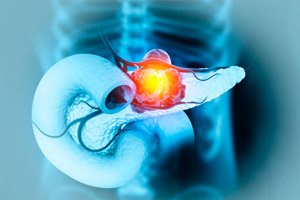
All iLive content is medically reviewed or fact checked to ensure as much factual accuracy as possible.
We have strict sourcing guidelines and only link to reputable media sites, academic research institutions and, whenever possible, medically peer reviewed studies. Note that the numbers in parentheses ([1], [2], etc.) are clickable links to these studies.
If you feel that any of our content is inaccurate, out-of-date, or otherwise questionable, please select it and press Ctrl + Enter.
Diabetes without a cause: how early hyperglycemia signals a malignant tumor
Last reviewed: 09.08.2025
 ">
">Pancreatic adenocarcinoma (PaC) is one of the most insidious types of cancer: the diagnosis is usually late, and the five-year survival rate does not exceed 10%. Meanwhile, in 40-50% of cases, patients over 50 years of age develop new diabetes mellitus 6-12 months before the tumor is detected, which does not fit into the classic types I or II. It is this form, Pancreatic Cancer–Associated Diabetes Mellitus (PCDM), that experts examined in detail in a recent review in Trends in Endocrinology & Metabolism.
Clinical features of PCDM
- Sudden onset without obesity or family history of diabetes.
- Severe insulin resistance: Blood glucose often exceeds 200 mg/dL despite normal weight and lifestyle.
- Partial reversibility: after tumor removal, glycemic levels return to normal in a third of patients, indicating a direct role of the tumor.
Molecular mechanisms
Cytokine response
The tumor secretes high levels of IL-6 and TNF-α, which block the phosphorylation of the insulin receptor in muscle and liver, exacerbating peripheral insulin resistance.Tumor Secretome The
PaC secretome contains proteins such as REG4 and adrenomedullin, which directly suppress β-cell function and reduce insulin production.Induced ER stress and β-cell apoptosis
The exocrine pancreas affected by the tumor creates local oxidative stress and nutrient deficiency, which triggers UPR pathways (IRE1α, PERK) and leads to islet cell death.Metabolic competition
The growing tumor “consumes” glucose and lactate, changing systemic metabolism and stimulating the release of counter-insular hormones: glucagon and cortisol.
Practical conclusions
- Screening for new-onset diabetes: Anyone over 50 with new-onset diabetes and normal BMI should have a CT or MRI scan of the pancreas and a CA19-9 test.
- Antidiabetic therapy with anticarcinogenic effect. Metformin and DPP-4 inhibitors not only normalize glycemia, but also have antitumor properties, suppressing the proliferation of PaC cells.
“Uncovering the mechanisms of PCDM is not only a deepening of knowledge, but also a real chance for early detection of a hidden tumor,” emphasizes Z. Post, the first author of the review.
Prospects
- Biomarkers for prognosis: Study of the plasma PaC secretome profile for detection of PCDM at the preclinical stage.
- Targeted prevention. Use of precancer screening protocols among patients with new diabetes to reduce mortality from PaC.
- Human studies: Randomized controlled trials of metformin and DPP-4 inhibitors in PCDM to assess the impact on survival in PaC.
The authors highlight the following key points:
PCDM as a 'red flag'
"Sudden-onset diabetes in patients over 50 without classic risk factors is often an early sign of pancreatic cancer," says Z. Post. "Recognizing PCDM can open a window for timely diagnosis and improve survival."Molecular Link Between Metabolism and Tumor
“We have shown that tumor secretion of cytokines and tumor-specific factors directly impairs β-cell function and enhances insulin resistance,” notes co-author A. Martinez. “This explains why glycemia normalizes after tumor resection.”Potential of metformin and DPP-4 inhibitors
“Drugs such as metformin and DPP-4 inhibitors may play a dual role in controlling diabetes and limiting the growth of PaC,” adds C. Nguyen. “Clinical trials in this population are urgently needed.”The need for a multidisciplinary approach
“Patients with new diabetes should be examined not only by an endocrinologist, but also by an oncologist,” emphasizes L. Zhao. “Teamwork will help identify hidden tumors at early stages and reduce mortality.”
This review highlights the close relationship between metabolism and oncology and paves the way for early diagnosis and more effective treatment of pancreatic cancer through detection and management of PCDM.
